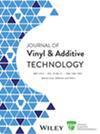Development and synthesis of anti-zinc burn and antibacterial Schiff base zinc complexes as multi-functional thermal stabilizers for PVC formulations
Abstract
Polyvinyl chloride (PVC) thermal stabilizers are evolving toward greater efficiency and multifunctionality. This study aims to develop a multifunctional thermal stabilizer to meet the diverse application requirements. A Schiff base, VanHis, was synthesized by condensing histidine with vanillin, and its zinc salt derivative, VanHis-Zn, was prepared by reacting VanHis with anhydrous zinc acetate. Infrared spectroscopy, proton nuclear magnetic resonance spectroscopy, and thermogravimetric analysis confirmed the successful synthesis. Thermal stability tests, including oven aging, thermogravimetric, conductivity, and Congo red tests, were conducted. Results showed that VanHis-Zn delayed zinc burn, with complete discoloration occurring after 120 min. Compared to commercially available calcium/zinc stearate stabilizers, VanHis-Zn exhibited the lowest weight loss rates in both the first (72.26%) and second (17.21%) stages. Additionally, dynamic mechanical analysis (DMA) and UV-absorption spectroscopy confirmed that VanHis-Zn suppressed the formation of conjugated double bonds during PVC thermal degradation. When blended with varying proportions of Ca(acac)2, the initial whiteness and long-term thermal stability of PVC samples improved significantly, doubling the stability time compared to conventional systems. Antibacterial tests also demonstrated that both VanHis-Zn and the blended PVC samples exhibited antibacterial properties. Quantum chemical calculations were performed to analyze the thermal stabilization mechanism using NPA charge distribution analysis.
Highlights
- VanHis-Zn from biomass enhances PVC stability under heat and delays zinc burning.
- VanHis-Zn imparts antibacterial properties and inhibits PVC conjugated bond formation.
- Thermal stability mechanism analyzed via quantum chemical and NPA charge analysis.




 求助内容:
求助内容: 应助结果提醒方式:
应助结果提醒方式:


